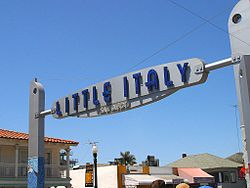Little Italy, San Diego
| Little Italy, San Diego | |
|---|---|
| Neighborhood of San Diego | |
| Little Italy | |

The Little Italy sign.
|
|
| Location within Central San Diego | |
| Coordinates: 32°43′27″N 117°10′2″W / 32.72417°N 117.16722°W | |
| Country | |
| State |
|
| County |
|
| City |
|
| Area | |
| • Total | 0.48 km2 (0.187 sq mi) |
| • Land | 0.48 km2 (0.187 sq mi) |
| Population (2008) | |
| • Total | 1,046 |
| • Density | 2,161/km2 (5,597/sq mi) |
| ZIP Code | 92101 |
| Area code(s) | 619 |
Little Italy is a somewhat hilly neighborhood in Downtown San Diego, California that was originally a predominately Italian fishing neighborhood. It has since been gentrified and now Little Italy is a scenic neighborhood composed mostly of Italian restaurants, Italian retail shops, home design stores, art galleries, and residential units.
Little Italy is one of the more active downtown neighborhoods and has frequent festivals and events including a weekly farmers market, also known as the Mercato (the Market, in Italian). The neighborhood has low crime rates when compared with other neighborhoods in Downtown San Diego and is maintained by the Little Italy Neighborhood Association, which looks after trash collection, decorations, and special events.
Little Italy is located in the northwest end of Downtown, just a few blocks away from the Embarcadero. It is located north of Columbia, south of Middletown, southeast of Core, and west of Cortez Hill. It is also located on a hill thus giving its hilly terrain.
This district is bordered by West Laurel Street to the north, West Ash Street to the south, Interstate 5/Front Street to the east and the San Diego Bay and Pacific Highway to the west.
India Street, the commercial corridor, runs through heart of Little Italy, intermingled with high-density mixed-use buildings and single-family bungalow style historic properties in a highly walkable 48 square block area.
From the 19th century through the 1970s, people from Italy led the enterprise in the building the boats to found the American tuna fishing fleet and canning industry based in San Diego, the "tuna capital" of the Western US. The first large tuna cannery, the Pacific Tuna Canning Company, was founded in 1911. By the mid-1930s the canneries employed more than 1,000 people. Due to rising costs and foreign competition the last of the canneries closed in the early 1980s. A large fishing fleet supported the canneries, mostly staffed by immigrant fishermen from the Portuguese Azores and Italy, whose influence is still felt in neighborhoods like Little Italy and Point Loma.
...
Wikipedia

